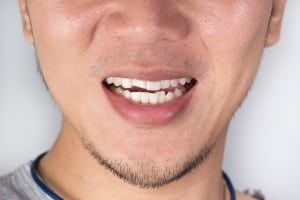Porcelain Veneers Vs. Bonding
Posted December 20, 2017 in Bonding, Porcelain Veneers Do you love your smile, or do you tend to hide it? Aesthetic problems such as chips, cracks, and gaps could be the reason you stay tight-lipped for photographs. Luckily, bonding and attaching porcelain veneers can help you restore a beautiful, natural-looking smile free of cracks, chips, and gaps. One of these techniques could be the perfect way to correct and enhance your smile.
Do you love your smile, or do you tend to hide it? Aesthetic problems such as chips, cracks, and gaps could be the reason you stay tight-lipped for photographs. Luckily, bonding and attaching porcelain veneers can help you restore a beautiful, natural-looking smile free of cracks, chips, and gaps. One of these techniques could be the perfect way to correct and enhance your smile.
Porcelain Veneers
Porcelain veneers can correct the appearance of teeth that are chipped, cracked, gapped, discolored, crooked, or even missing. Veneers are thin sheets of white porcelain that are cemented to the front of the teeth to improve their appearance and function.
The Procedure
To attach a veneer, your dentist will first shave off a thin layer of enamel and take a mold of your teeth so that customized veneers can be made. Next, you will be fitted with temporary veneers while the permanent veneers are being fabricated. Just two or three weeks later, your personalized veneers will be permanently cemented to your teeth. However, depending on the situation, sometimes the veneers are made in the office and can be ready the same day.
Advantages and Disadvantages
The most significant advantage of porcelain veneers is that they have versatile uses and can improve a variety of cosmetic complaints. For example, if your teeth are discolored in addition to being chipped or cracked, veneers can resolve both problems simultaneously. They can also be designed to match your surrounding teeth perfectly. However, due to the process of shaving your teeth, veneers are permanent. The procedure must also be performed in two stages. Although the process does not need anesthesia, it often times requires numbing. The results are immediate and long lasting. On average, veneers may need to be replaced after 10 to 15 years (they last at least two or three times longer than bonding).
Bonding
Tooth bonding corrects the appearance of chips, cracks, or gaps using tooth-colored composite resin materials. The composite resin is hardened to the tooth’s surface and can be used to improve the appearance of teeth and to repair or protect teeth.
The Procedure
For this procedure, your dentist will apply a natural, tooth-colored composite resin to your teeth. First, a gentle acid solution will be applied to your teeth to prepare them for the bonding material. A liquid bonding will then be molded to the tooth to fit the desired shape. Finally, an ultraviolet light will be placed to harden the resin until it is cemented to your tooth.
Advantages and Disadvantages
While veneers require two office visits, bonding can usually be accomplished in a single visit. The procedure is quick and comfortable. However, bonding is more limited in its uses. Additionally, the bonding material may need to be replaced after three to five years, which is typically sooner than necessary with veneers. Nonetheless, bonding does have the ability to correct cosmetic issues such as gaps, cracks, and chips, and it can repair or protect damaged or vulnerable teeth.